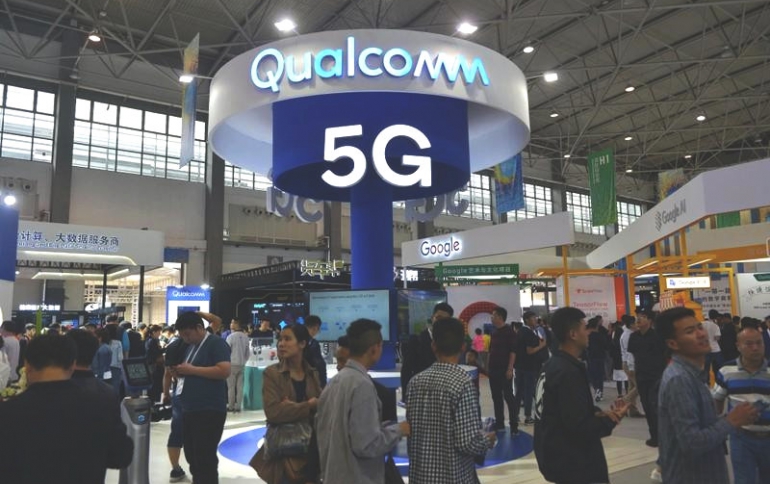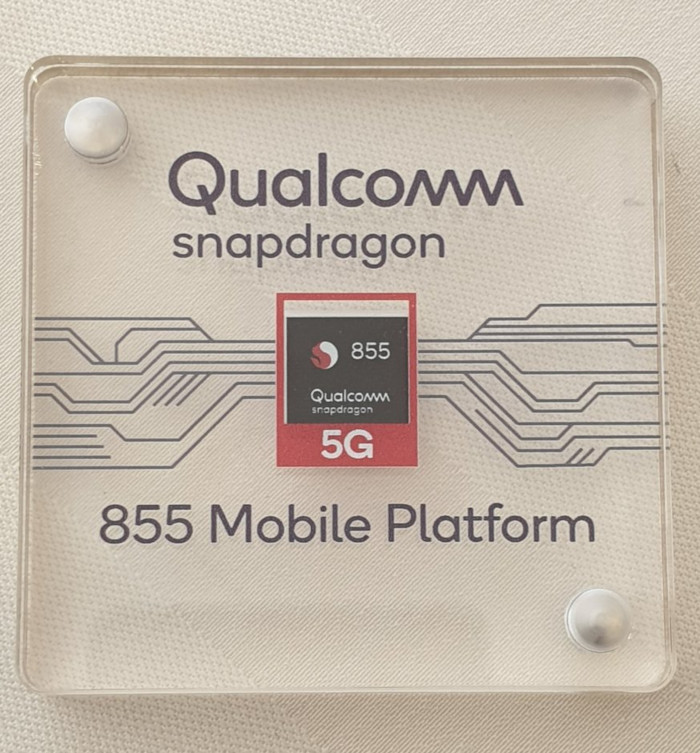
Qualcomm Unveils New Snapdragon 855 to Power 5G Smartphones
During the first day of the annual Snapdragon Technology Summit, Qualcomm Technologies, Inc., brought together global mobile operators, infrastructure providers device to introduce the first commercial 5G mobile platform, Qualcomm Snapdragon 855 Mobile Platform.
During a keynote address, Cristiano Amon, president, Qualcomm Incorporated, discussed the progress and leadership Qualcomm Technologies has shown on the path to commercialization of 5G. He described how 5G will be a commercial reality starting in early 2019 with mobile device launches and network rollouts across North America, Europe, Japan, South Korea, Australia and China. Amon also reviewed how Qualcomm Technologies is positioned to propel 5G deployments with the Snapdragon 855 mobile platform, the Snapdragon X50 5G modem family and Qualcomm QTM052 mmWave antenna modules with integrated RF transceiver, RF front-end and antenna elements — helping OEMs address the increase in device design complexity that comes with 5G in both sub-6 GHz and mmWave bands.
"Today marks a massive and exciting step forward underscoring how Qualcomm Technologies and ecosystem leaders are driving 5G commercialization, a journey that went from R&D, accelerated standardization and trials, the launch of innovative products and technologies, to the imminent launch of 5G networks and smartphones across the globe starting in early 2019," said Amon. "Together we are demonstrating our role in transforming the mobile industry and enriching consumer experiences with 5G mobile devices on live 5G networks at this year’s Qualcomm Snapdragon Technology Summit."
Amon was then joined on stage by senior executives from global mobile operators AT&T, EE and Verizon, who discussed in more detail their 5G deployment plans. Nicki Palmer, chief network engineering officer at Verizon, discussed Verizon’s 5G strategy and the importance of collaboration in making 5G a reality; Kevin Petersen, senior vice president, wireless product marketing at AT&T, highlighted 5G commercialization along with the industries & key consumer experiences that will drive demand for the next generation mobile network; Fotis Karonis, executive advisor for 5G at BT Group, discussed how 5G will roll out across the UK in 2019, address challenges that LTE currently faces and introduce new customer experiences. Additionally, at the event, Qualcomm Technologies, AT&T and Verizon turned on live millimeter wave 5G networks and showcased a number of 5G consumer experiences powered by the Snapdragon X50 5G Modem and RF subsystem. Telstra is scheduled to share a 5G update during the second day of the summit.
Ericsson set up a 5G network at a Qualcomm event to give press and analysts a first look at what its new chip sets will enable.
Samsung's early version of its first 5G smartphone streamed 4K video to a large-screen TV. Motorola demoed a 5G upgrade module that attached to its LTE smartphone to download a gigabyte movie in 17 seconds.

For its part, Motorola showed a 5G clip-on for its Moto Z family, exclusive to Verizon’s network. It weighs about 125g, so the smartphone -mod combination is about 280g. Under the hood, the mod has ten antenna modules in all four corners so hands won’t block signals. The four of them are Qualcomm’s small QTM052 antenna modules for 28 GHz mmWave functionality. Two of the antennas are for sub-6 GHz connectivity, and the other four are for LTE. The unit also contains a Snapdragon 855 SoC inside along with the X50 modem. A 2000 mAh battery inside the mod ispowering the the X50 modem (and 855 SoC).

Inseego Corp.and Verizon unveiled the MiFi 5G NR mobile broadband technology. The two companies conducted a live virtual reality telemedicine demonstration in partnership with Columbia University using an Inseego mobile hotspot device, powered by the Qualcomm Snapdragon 855 Mobile Platform and Snapdragon X50 5G modem and antenna modules with integrated RF transceiver, RF front-end and antenna elements, running on Verizon’s 5G NR mobile network deployed at the event venue. The device also offers next generation Wi-Fi performance using the Qualcomm Wi-Fi 6-ready mobile solution. The Inseego mobile hotspot launches on the Verizon network in 2019.

Samsung Electronics America, Inc., Qualcomm Technologies, and Verizon announced a successful 5G New Radio (NR) data connection using 400MHz of bandwidth in the 28GHz spectrum, resulting in maximum throughput of more than 1.7 Gbps.
The data connection demonstrated the delivery of multi-gigabit 5G speeds to a smartphone form-factor mobile test device, with a focus on uninterrupted data transmission using 3GPP 5G NR specification and dual connectivity (known as EN-DC1). The test used Samsung’s commercial 5G NR and 4G LTE equipment to deliver the 5G NR data transmission using Verizon’s 28 GHz spectrum.
The data throughput of more than 1.7 Gbps was delivered to a Qualcomm Technologies’ smartphone form factor test device with a Qualcomm Snapdragon X50 5G modem and antenna modules with integrated RF transceiver, RF front-end and antenna elements.

The lack of support for frequency duplex division in the current 5G modems is delaying deployment in sub-6-GHz bands until late 2019 for AT&T and possibly other carriers.
Data rates for the first batch of handsets will likely be limited to a few hundred Mbits/second. Meanwhile, vendors are working on consumer-friendly metrics to help users set their expectations.
All three carriers in South Korea officially launched services over the weekend, dubbing December 1 as “5G Day.” AT&T is next, having promised a 2018 rollout based a first cut of the 3GPP’s standard released in June.
Carriers report better-than-expected reach with millimeter wave signals, but the data rates they deliver are still far below their multi-Gbit potential.
Verizon showed a video boasting its fixed-wireless services delivering in some cases 780 Mbits/s to 1.04 Gbits/s. However, it officially promises just 300 Mbits/s.
Representatives of AT&T, EE Ltd. and Verizon declined to share information on their expected 5G data rates and prices before their official launches.
Alex Katouzian, senior vice president and general manager, mobile, Qualcomm Technologies, Inc. unveiled at the event the 7nm Snapdragon 855 Mobile Platform, the world’s first commercial mobile platform supporting multi-gigabit 5G, AI and extended reality (XR) collectively. Qualcomm said that the Snapdragon 855 delivers "highly intuitive" on-device AI experiences – driven by our 4th-generation, multi-core Qualcomm AI Engine, with up to 3 times the AI performance compared to the previous generation mobile platform. It also features the first Computer Vision (CV) ISP to enable computational photography and video capture features. The platform also delivers the Snapdragon Elite Gaming, bringing "next level gaming experiences" to premium mobile devices. The chip supports "true 4K HDR video capture, cinema-grade photography capabilities" and Qualcomm's 3D Sonic Sensor. This is the first commercial ultrasonic fingerprint solution supported under the display. This is the only mobile solution that can accurately detect fingerprints through numerous contaminants. Furthermore, this technology enables sleek form factors while distinguishing itself from alternatives with higher levels of security and accuracy.

In-display fingerprint sensors aren't new - Vivo launched the world's first phone with one in early 2018, and OnePlus recently brought a similar technology to the United States in its new 6T flagship.
Qualcomm's approach is a bit different. Rather than just store a flat image of your thumb pressed up against the screen, the company's sonic sensor uses sound waves to build a three-dimensional mold of your finger. Because it doesn't rely on visual data, Qualcomm's sensor should be much better at recognizing your fingerprints. And since it's meant to capture a full mold of your finger — right down to the ridges and pores — the possibility of fooling this kind of sonic sensor is significantly smaller.
During the event, Justin Denison, senior vice president of mobile product strategy and marketing, Samsung Electronics America, discussed the company’s commitment to 5G, including bringing the first flagship 5G smartphone to the U.S. in the first half of 2019 using the Snapdragon 855 Mobile Platform with the 5G X50 modem.




















